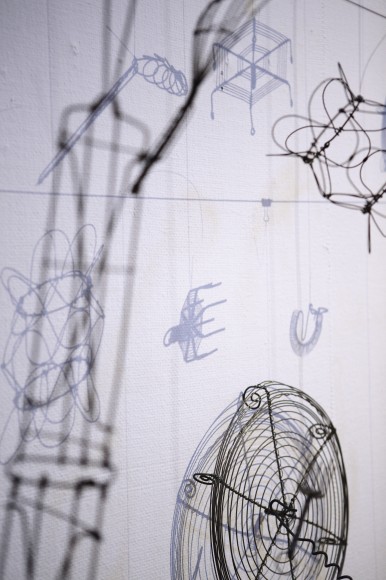|

ARKIV
For “Garden of Learning”, Norwegian artist Guttorm Guttormsgaard proposes a succession of rooms beginning with a camera obscura. The subsequent rooms display the artist’s own collection of artworks, artifacts and books, including his own opus magnum: ARKIV.The camera obscura is a completely dark room. A light beam projects through a tiny hole, casting an image of the world outside upside down on a screen. This image reveals the world as an apparition rather than a fact, thus contradicting our experience of being born into a world that always already exists.The next room we enter is still clad in darkness. Two objects await us: a massive piece of wood and a moveable tractor wheel filled with pebbles. Some of Guttormsgaard’s artworks can be seen on the walls: prints of moving stones, variations on sea waves and drawings of the wooden piece (a seaworn stub). Once our eyes have been cleared in the camera obscura, these objects awaken our senses of touch and hearing.The third room displays some 100 objects, images, prints and books in a loose, associative fashion. Every single item has been culled from Guttormsgaard’s own, vast collection (from which the artist has conceived more than 60 exhibitions over the last decade or so).
The artist’s choice for “Garden of Learning” includes a Korean lumberjack’s tool, a Japanese Mangwa from the late 19th century, a series of postcards with images of Norways’s mountain roads, the eyes of a toy doll, a Jaguar car logo figure and a photo book by Weegee.There is no overall classification for this idiosyncratic collection. Instead, the artist proposes a form of sensual collaboration with the viewer – one that requires an open mind. The associative connections we make will probably begin with the formal properties of any given object. They will be based upon a strange, very personal mix of conscious and unconscious memories (of things we remember vaguely or that look similar), as well as bits and pieces of knowledge (the Jaguar driver might easily recognize the logo, but may not be able to place the lumberjack’s tool).Finally we come to ARKIV, which is displayed in one long row of open pages. This book, made by Guttormsgaard, could be called the destiny of the artist’s collection. In it, every item is given its proper place.
|